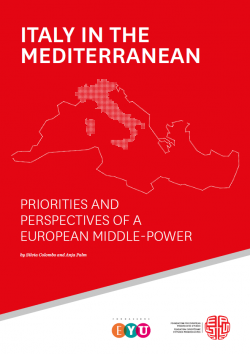Italy in the Mediterranean. Priorities and Perspectives of a European Middle Power

The Mediterranean has always represented a main source of opportunities and challenges for Italy’s domestic and foreign policy. This strategic importance has also stemmed from the role that this region played in the construction and integration process of the European Union. The fact that both regions in the north and south of the Mediterranean Sea are currently experiencing deep internal crises does not diminish the importance of this geopolitical space and the EU’s resolution to project its influence over it. This report addresses the broad topic of ‘Italy in the Mediterranean’ in order to shed light on the drivers, priorities and concrete actions Italy has pursued vis-à-vis this region in the period 2016-2018. It argues that domestic and geopolitical changes as well as the lack of cohesion and solidarity among EU member states on specific issues, particularly migration, have been responsible for some important changes that have occurred in Italy’s Mediterranean approaches.
-
Dati bibliografici
Bruxelles/Roma, Foundation for European Progressive Studies (FEPS) e Fondazione EYU, 2019, 35 p.
1.1 Italy’s traditional and changing role in the Mediterranean: Challenges and opportunities
1.1.1 The partial re-orientation of Italy’s Mediterranean policies towards North Africa, the Sahel and Africa
1.1.2 The EU’s Euro-Mediterranean frameworks of cooperation and the role of Italy
1.2 Italy’s toolkit and partnerships in the region: The tension between multilateral and bilateral instruments
1.2.1 The consolidation of important economic links as a foreign policy tool
1.2.2 Libya and Egypt: Two cases of Realpolitik
2.1 Migration flows in the Mediterranean
2.1.1 Routes, figures and drivers of migration flows crossing the Mediterranean to the EU
2.1.2 Routes, figures and origins of migration flows to Italy
2.2 Italy’s external migration policies in the Mediterranean between EU actions and bilateral initiatives
2.2.1 The Italian approach to external migration policy
2.2.2 Italian demands and actions within the EU framework
2.2.3 Bilateral initiatives in 2017-2018
2.2.4 Italian and European missions in the Central Mediterranean
Conclusions



